Calf Crops are the No. 1 indicator of Business Success

Reproduction is the most important economic trait in a beef cow herd.
“Selling more calves as it relates to cows exposed and cow input costs is a greater indication of business success than any other production parameter,” says Gerald Stokka, North Dakota State University Extension veterinarian and livestock stewardship specialist. “Unfortunately, the majority of our expected progeny differences measure production traits not related to reproduction, while the index values focus on gross revenue, not input costs.”
Take, for example, a 300-cow herd with a 15% open rate and a normal average of 5%. The open rate is 10% higher than normal. This means that 270 cows must assume the cost of maintaining 300 cows. If cow costs on an annual basis are $700, then each of the 270 pregnant cows will pick up the tab for $778.
Easy answers to reducing the rate of open cows, such as changing vaccination protocols, usually are misguided and don’t address the fundamental reasons for low pregnancy rates, according to Stokka.
“Meaningful discussion to find solutions requires a systematic approach to practical management recommendations,” he says.
For you to help beef producers, Stokka says you need access to production information related to the following: calving dates, pregnancy checking information by fetal age, cow body condition scores (BCS), cow BCS by age, cow age, cow age by pasture information, bull age and cows exposed per bull, length of the breeding season, and biosecurity of the herd related to purchases, exposure to the main herd and exposures to neighboring cattle.
Here is additional information you need to discuss with producers to develop solutions to open cows and low pregnancy rates:
What time of the year is calving season? Late winter/earlier spring calving requires more energy in the diet to prepare cows to be rebred during the breeding season. Late spring/ summer calving cows may experience a decrease in forage quality in late July and August, which can impact fertility
What is the calving season distribution—when are most calves born? Is it the first 21 days, the first 45 days, the last 30 days or scattered throughout the calving season? This information provides some evidence of inadequate bull power, which may be related to dominant bulls, lame bulls, injured bulls or inadequate BCS and cow nutrition during the breeding season. A large number of cows determined to be pregnant late in the breeding season could be an indication of reproductive disease such a vibrio or trichomoniasis.
What is the number of calves born related to the number of cows determined to be with calf at the previous pregnancy checking event? This number could indicate fetal loss due to abortions not noticed, or obvious abortions and stillbirths. This can be evidence of fetal infections such as BVDV, IBR, leptospirosis, Neospora, fungal infections and a host of other possible pathogens. In addition, fetal losses can be due to high nitrates in forage resources.
What is the cow BCS and by age? Younger cows (2- and 3-year-olds) and cows more than 12 years old generally will carry less condition than middle-aged cows. This will have a direct relationship to the ability to rebreed and conceive for the next season because young cows still are growing and lactating, and older cows will have more difficulty staying in condition because most of their incisor teeth will be missing.
What are the cow and bull ages and numbers by pasture? Herds with younger or older cows in common pastures regardless of bull numbers generally will have a greater number of open cows. The number of cows exposed per bull is important, but perhaps even more important is bull age.
Older and more dominant bulls tend to serve the majority of cows, so the number of bulls may not be as important as the age of all the bulls in a pasture. Running two 14- to 16-month-old bulls with a single dominant older bull counts as three bulls. However, in reality, the herd may have only 1.5 bulls because the dominant bull dominates the breeding. All bulls should have had a bull semen evaluation prior to the breeding season. Bulls from pastures with low pregnancy rates should be tested again.
Do your clients make biosecurity and vaccination a priority? All purchased and additions to the herd should have a testing and vaccination history. If not, then your producers should implement quarantine procedures. Even with testing and vaccination, do not introduce new additions into the herd just prior to the start of the calving season.
“Beef cow pregnancy and weaning rates are important numbers to track,” Stokka says. “High numbers without increased input costs are related to profitability and sustainability of the ranch business. Work with producers and nutritionists in herds where appropriate benchmarks or goals of these rates have not been achieved.”







